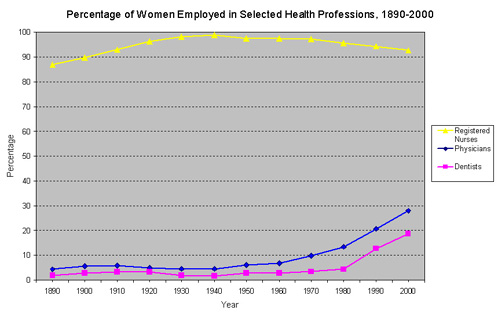By the Numbers
The Changing Representation of Women in the Health Sciences
The entry of women into professional employment during the second half of the 19th century is rooted in the increasingly widespread availability of public education, the expansion of women’s “sphere,” and the growth of women’s rights. Nineteenth century reform movements, especially health reform, played a part in increasing awareness of public health and social hygiene issues. Teaching, medicine, nursing, and social reform were seen as natural extensions of woman’s traditional sphere of influence, expanding the traditional roles of mother and nurturer.
U.S. Census Bureau figures from 1870 to 1920 reveal a steadily increasing percentage of women employed in professional service:
In the decades following Elizabeth Blackwell’s 1849 graduation from Geneva Medical College, hundreds of women sought medical training. By 1900 over 7,000 women were employed as physicians – about 6% of the total number. In some cities, such as Boston, the percentage of woman physicians was as high as 18%.
Dr. Lucy Beeman Hobbs Taylor was the first woman to receive a dental degree in the United States, graduating in 1866 from the Ohio Dental College. By 1900, over 800 women were dentists – about 3% of the total.
Though the first training classes for nurses in the United States were organized by Dr. Valentine Seaman in 1798 at the New York Hospital, the first true training schools for nurses were organized in the years following the Civil War. By 1900 over 100,000 women were employed as nurses. The growth of professional nursing corresponded to advances in medical knowledge and the rapid rise in the number of hospitals in the United States in the last quarter of the 19th century. Nursing has remained a predominately female profession since the advent of training schools.
The percentages of woman physicians and dentists remained relatively constant until the 1960s, when a marked increase began. More women applied to and were accepted into medical and dental schools. Since the 1960s, the percentage of women employed as physicians and dentists has greatly increased:
Related Links:
Return to By the Numbers
Back to Top


